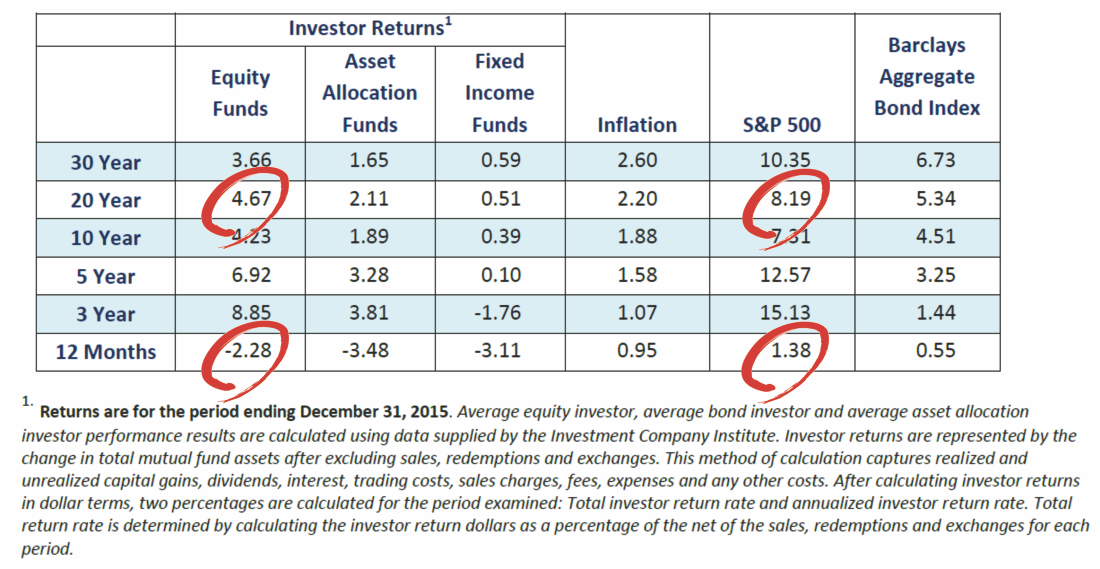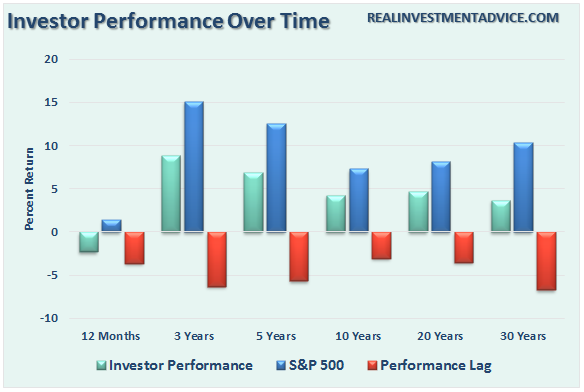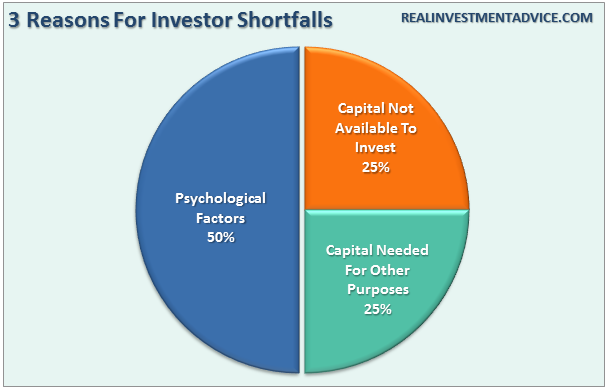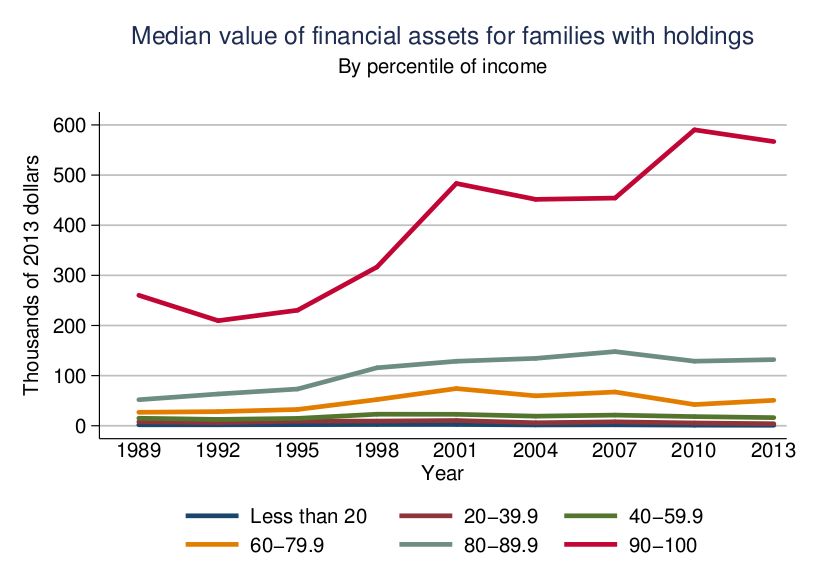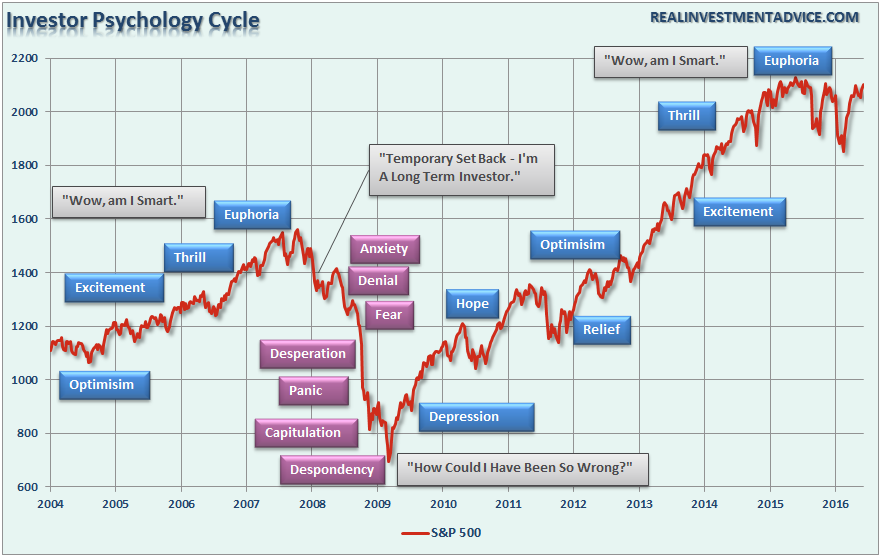A couple of years ago I wrote an article discussing Dalbar’s annual Quantitative Analysis Of Investor Behavior study. The study showed just how poorly investors perform relative to market benchmarks over time and the reasons for that underperformance.
With the release of Dalbar’s latest study, I thought it would be prudent to both update, and remind you, of the problems investors continue to face despite the ongoing media and mainstream rhetoric about “investing for the long-term” and other such nonsense.
First of all, let’s dismiss the notion that it is possible for an investor to consistently “beat” an index over long periods of time.
It isn’t.
Indexes do not account for the impact of taxes, trading costs, and fees, over time. There are also internal dynamics of an index that affect long term performance which does not apply to an actual portfolio such as share buybacks, substitution, and market-cap valuation.
(For more on the reasons why benchmarking is a bad strategy click here and here.)
However, even the issues shown above do not fully account for the underperformance of investors over time. The key findings of the study show that:
- In 2015, the average equity mutual fund investor underperformed the S&P 500 by a margin of 3.66%. While the broader market made incremental gains of 1.38%, the average equity investor suffered a more-than-incremental loss of -2.28%.
- In 2015, the average fixed income mutual fund investor underperformed the Barclays Aggregate Bond Index by a margin of 3.66%. The broader bond market realized a slight return of 0.55% while the average fixed income fund investor lost -3.11%.
- In 2015, the 20-year annualized S&P return was 8.19% while the 20-year annualized return for the average equity mutual fund investor was only 4.67%, a gap of 3.52%.
Here is a visual of the lag between expectations and reality.
However, here are some key findings:
Diversification is a myth.
“Asset classes tend to become more correlated during market corrections, somewhat muting the benefits of diversification and necessitating a downside protection strategy that goes beyond traditional diversification.”
In other words, when the next recessionary market correction comes, not having a “sell discipline” or a “hedging strategy” is going to expose investors, and clients, to substantial capital destruction. This will particularly be the case in high yield, dividend based investments where investors and advisors have been crowding assets.
Poor Recommendations Not A Problem
“No evidence has been found to link predictably poor investment recommendations to average investor underperformance. Analysis of the underperformance shows that investor behavior is the number one cause, with fees being the second leading cause.”
As I will discuss more in a moment, given the high correlation across the markets, sectors and asset classes, poor recommendations are somewhat muted. As is always the case, a ramping bull market hides investor mistakes – it is the bear market that reveals them. However, it is psychology and fees that are the leading causes of underperformance during a bull market advance.
Advisors Must Be Psychologists
“Acting in the investor’s best interest should include affirmative practices to curb harmful behaviors.”
Why You (Still) Suck At Investing
Accordingly to the Dalbar study, the three primary causes for the chronic shortfall for both equity and fixed income investors is shown in the chart below.
Notice that while “fees” are important to overall returns, they are not a key issue to the majority of underperformance by individual investors. As shown above, the key issues come down to primarily a lack of capital to invest and psychology.
As stated, the issue of “costs” are an important consideration when choosing between two specific investment options; however, the emotional mistakes made by investors over time are much more important. Let’s examine each of these issues.
Lack Of Capital
Over the last few years, the investing public has been consistently bashed by the mainstream media and analysts for “missing the rally.” Of course, it would be helpful if Wall Street had not been telling individuals to stay invested during the last two bear market corrections that wiped out a tremendous amount of investible wealth. (More on that in a moment.)
In order for individuals to invest, they must have discretionary “savings” with which to invest with. Unfortunately, between weak economic growth, stagnant incomes, rising costs of living and two major “bear” markets; nearly 80% of Americans simply are not able to participate as shown by numerous studies and statistical facts over the last few years:
- According to the Pew Research Center, the median income of middle-class households declined by 4 percent from 2000 to 2014.
- The Pew Research Center has also found that median wealth for middle-class households dropped by an astounding 28 percent between 2001 and 2013.
- There are still 900,000 fewer middle-class jobs in America than there were when the last recession began, but the population has grown significantly larger since that time.
- According to the Social Security Administration, 51 percent of all American workers make less than $30,000 a year.
- An astounding 48.8 percent of all 25-year-old Americans still live at home with their parents.
- According to the U.S. Census Bureau, 49 percent of all Americans now live in a home that receives money from the government each month, and nearly 47 million Americans are living in poverty right now.
- In 2007, about one out of every eight children in America was on food stamps. Today, that number is one out of every five.
- The median net worth of families in the United States was $137, 955 in 2007. Today, it is just $82,756.
You get the idea. The economic backdrop has not been one that allows for participation by the average investor in the financial markets. As I discussed in “For 90% Of Americans There Has Been No Recovery,” the Federal Reserve shows that the majority of the benefit of surging asset prices has been concentrated in the top 10% of income earners in the country, or those with capital to invest.
The lack of capital to invest, for either reason listed above, has been a serious impedance to the growth of wealth over time. But if you still aren’t quite getting it – let’s put it this way:
“If you have no debt and you also $10 in your pocket, that gives you a greater net worth than about 25 percent of all Americans.”
It’s Your Brain, Man
While the inability to participate in the financial markets is certainly a major issue, the biggest reason for underperformance by investors who do participate in the financial markets over time is psychology. Behavioral biases that lead to poor investment decision-making is the single largest contributor to underperformance over time. Dalbar defined nine of the irrational investment behavior biases specifically:
- Loss Aversion – The fear of loss leads to a withdrawal of capital at the worst possible time. Also known as “panic selling.”
- Narrow Framing – Making decisions about on part of the portfolio without considering the effects on the total.
- Anchoring – The process of remaining focused on what happened previously and not adapting to a changing market.
- Mental Accounting – Separating performance of investments mentally to justify success and failure.
- Lack of Diversification – Believing a portfolio is diversified when in fact it is a highly correlated pool of assets.
- Herding– Following what everyone else is doing. Leads to “buy high/sell low.”
- Regret – Not performing a necessary action due to the regret of a previous failure.
- Media Response – The media has a bias to optimism to sell products from advertisers and attract view/readership.
- Optimism – Overly optimistic assumptions tend to lead to rather dramatic reversions when met with reality.
The biggest of these problems for individuals is the “herding effect” and “loss aversion.”
These two behaviors tend to function together compounding the issues of investor mistakes over time. As markets are rising, individuals are lead to believe that the current price trend will continue to last for an indefinite period. The longer the rising trend last, the more ingrained the belief becomes until the last of “holdouts” finally “buys in” as the financial markets evolve into a “euphoric state.”
As the markets decline, there is a slow realization that “this decline” is something more than a “buy the dip” opportunity. As losses mount, the anxiety of loss begins to mount until individuals seek to “avert further loss” by selling.
As shown in the chart below, this behavioral trend runs counter-intuitive to the “buy low/sell high” investment rule.
In the end, we are just human. Despite the best of our intentions, it is nearly impossible for an individual to be devoid of the emotional biases that inevitably lead to poor investment decision-making over time. This is why all great investors have strict investment disciplines that they follow to reduce the impact of human emotions.
More importantly, despite studies that show that “buy and hold,” and “passive indexing” strategies, do indeed work over very long periods of time; the reality is that few will ever survive the downturns in order to see the benefits.
But then again, since the majority of American’s have little or no money with which to invest, maybe a bigger problem is the lack of financial education to begin with.
New Tips For Advisors
The Dalbar study delves into the importance of event recognition. Knowing that advisory clients are emotional and subject to emotional swings caused by market volatility, Dalbar suggests four successful practices to reduce harmful behaviors:
- Set Expectations below Market Indices: Change the threshold at which the fear of failure causes investors to abandon investment.
Set reasonable expectations and do not permit expectations to be inferred from historical records, market indexes, personal experiences or media coverage. The average investor cannot be above average. Investors should understand this fact and not judge the performance of their portfolio based on broad market indices.
- Control Exposure to Risk: Include some form of portfolio protection that limits losses during market stresses.
Explicit, reasonable expectations are best set by agreeing on a goal that consists of a predetermined level of risk and expected return. Keeping the focus on the goal and the probability of its success will divert attention away from frequent fluctuations that lead to imprudent actions
- Monitor Risk Tolerance: Periodically reevaluate investor’s tolerance for risk, recognizing that the tolerance depends on the prevailing circumstances and that these circumstances are subject to change.
Even when presented as alternatives, investors intuitively seek both capital preservation and capital appreciation. Risk tolerance is the proper alignment of an investor’s need for preservation and desire for capital appreciation. Determination of risk tolerance is highly complex and is not rational, homogenous nor stable.
- Present forecasts in terms of probabilities: Simply stating that past performance is not predictive creates a reluctance to embark on an investment program.
Provide credible information by specifying probabilities or ranges that create the necessary sense of caution without negative effects. Measuring progress based on a statistical probability enables the investor to make a rational choice among investments based on the probability of reward.
The challenge, of course, it understanding that the next major impact event, market reversion, will NOT HAVE the identical characteristics of the previous events. This is why comparing today’s market to that of 1994 or 2000 is pointless. As I have stated many times previously:
“When the crash ultimately comes the reasons will be different than they were in the past – only the outcome will remain same.”
However, it is extremely critical that careful judgment is used in identifying a potential impact event is imperative. As Howard Marks once stated:
“Being early is the same as being wrong.”
Advisors Must Take Action Before The Event
Dalbar’s data shows that the “cycle of loss” starts when the investor abandons their investments which is followed by a period of remorse as the markets recover (sells low). Of course, the investor eventually re-enters the market when their confidence is restored (buys high). Preventing this cycle requires having a plan in place beforehand.
When markets decline, investors become fearful of total loss. Those fears are compounded by the barrage of media outlets that “fan the flames” of those fears. Advisors, need to remain cognizant of client’s emotional behaviors and substantially reduce portfolio risk during major impact events while repeatedly delivering counter-messaging to keep clients focused on long-term strategies.
Dalbar notes that during impact events messages delivered to clients should have three characteristics to be effective at calming emotional panic:
- Messages must be delivered at the time the fear is present. As mentioned earlier, messages delivered before the investor actually experiences the event will not be effective. If the messages are too long after the fact, decisions will have been made, and actions taken that are very difficult to reverse.
- Messages must relate directly to the event causing the fear. Providing generic messages such as the market has its ups and downs are of little use during a time of anxiety.
- Messages must assure recovery. Qualified statements regarding recovery tend to fuel fear instead of calming it.
Messages must ALSO present evidence that forms the basis for forecasting recovery. Credible and quotable data, analysis and historical evidence can provide an answer to the investor when the pressure mounts to “just do something”. Providing “generic media commentary” with a litany of qualifiers to specific questions will most likely fail to calm their fears.
Understanding how individuals respond to impact events will allow advisors to get in front of their clients to discuss the planning, preparation and response to an impact event and recovery.
One thing that all the negative behaviors have in common is that they can lead investors to deviate from a sound investment strategy that was narrowly tailored towards their goals, risk tolerance, and time horizon. The best way to ward off the aforementioned negative behaviors is to employ a strategy that focuses on one’s goals and is not reactive to short-term market conditions. The data shows that the average mutual fund investor has not stayed invested for a long enough period of time to reap the rewards that the market can offer more disciplined investors. The data also shows that when investors react, they generally make the wrong decision.
The reality is that the majority of advisors are ill-prepared for an impact event to occur. This is particularly the case in late-stage bull market cycles where complacency runs high.
This complacency can be seen in the shift from active portfolio management strategies to passive indexing which is a hallmark sign of a late-stage bull market. When the impact event occurs, the calls to 1-800-ROBOADVISOR for calming messages and a plan to avoid major losses of capital will go unanswered. Advisors who are prepared to handle those responses, provide clear messaging and an action plan for both conserving investment capital and eventual recovery will find success in obtaining new clients.
The discussion of why “this time is not like the last time” is largely irrelevant. Whatever gains that investors garner in the between now and the next impact event by chasing the “bullish thesis” will be wiped away in a swift and brutal downdraft. Of course, this is the sad history of individual investors in the financial markets as they are always “told to buy” but never “when to sell.”
You can do better.
Lance Roberts
Lance Roberts is a Chief Portfolio Strategist/Economist for Clarity Financial. He is also the host of “The Lance Roberts Show” and Chief Editor of the “Real Investment Advice” website and author of “Real Investment Daily” blog and “Real Investment Report“. Follow Lance on Facebook, Twitter, and Linked-In

